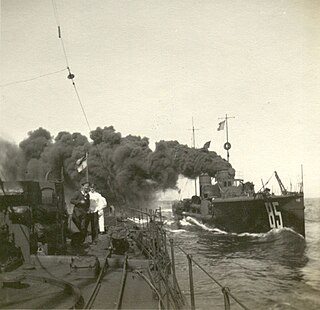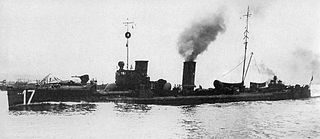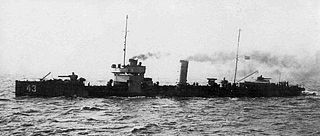
Italian torpedo boat Premuda was a 1916 Type Large Torpedo Boat of the Imperial German Navy during World War I. Built as SMS V116 she was the first ship of her class to be launched.

SMS S36 was a 1913 Type Large Torpedo Boat of the Imperial German Navy during World War I, and the 12th ship of her class. She was equipped with of three single mounted 8.8 cm SK L/45 naval guns and with six 50 cm (19.7 in) torpedo tubes, two forward and four aft; twenty-four mines could also be carried. She was launched on 17 October 1914 and commissioned on 4 January 1915. S36 took part in the Battle of the Gulf of Riga in 1915 and the Battle of Jutland in 1916. In late 1916 she served in the English Channel and took part in a number of engagements, including the Battle of Dover Strait during which a British merchant ship and a destroyer were sunk by her Half-Flotilla. She was scuttled at Scapa Flow in 1919.
SMS V46 was a 1913 Type Large Torpedo Boat of the Imperial German Navy during World War I. She was built by AG Vulcan at their Stettin shipyard, being launched on 23 December 1914 and completing in October 1915.
SMS S13 was a V1-class torpedo boat of the Imperial German Navy. The ship was built by Schichau-Werke, at their Elbing shipyard, completing in 1912. She served in the First World War with the German High Seas Fleet, taking part in the Battle of the Heligoland Bight in 1914. She was sunk by an accidental explosion on 6 November 1914.

SMS G102 was a G101-class large torpedo boat operated by Imperial German Navy during the First World War. The ship was ordered for the Argentine Navy from the German shipyard Germaniawerft as the San Luis, but was still under construction at the start of the war and was seized by Germany.

SMS V185 was a S-138-class large torpedo boat of the Imperial German Navy. She was built by the AG Vulcan shipyard at Stettin in 1910, launching on 9 April that year.
SMS G10 was a V1-class large torpedo boat of the Imperial German Navy. She was built by the Germaniawerft shipyard at Kiel between 1911 and 1912, completing on 28 August 1912.
SMS G11 was a V1-class large torpedo boat of the Imperial German Navy. She was built by the Germaniawerft shipyard at Kiel between 1911 and 1912, completing on 8 August 1912.
SMS S14 was a V1-class torpedo boat of the Imperial German Navy. She served with the German High Seas Fleet at the start of the First World War, and was sunk by an internal explosion on 19 February 1915.
SMS S15 was a V1-class torpedo boat of the Imperial German Navy. The ship was built by Schichau-Werke, at their Elbing shipyard, completing in 1912.
SMS S16 was a V1-class torpedo boat of the Imperial German Navy. The ship was built by Schichau-Werke, at their Elbing shipyard, completing in 1912. S16 served with the German High Seas Fleet during the First World War, taking part in the Battle of Jutland in 1916. She was sunk by a mine on 20 January 1918.

SMS S17 was a V1-class torpedo boat of the Imperial German Navy. The ship was built by Schichau-Werke, at their Elbing shipyard, completing in 1912. S17 served with the German High Seas Fleet during the First World War, taking part in the Battle of Jutland in 1916. She was sunk by a mine on 16 May 1917.

SMS S18 was a V1-class torpedo boat of the Imperial German Navy. The ship was built by Schichau-Werke, at their Elbing shipyard, completing in 1912. S18 served with the German High Seas Fleet during the First World War, taking part in the Battle of Jutland in 1916. S18 survived the war, serving in the Weimar Republic's Reichsmarine. She was scrapped in 1935.

SMS S19 was a V1-class torpedo boat of the Imperial German Navy. The ship was built by Schichau-Werke, at their Elbing shipyard, completing in 1913. S19 served with the German High Seas Fleet during the First World War, taking part in the Battle of Jutland in 1916. The ship survived the war, serving in the Weimar Republic's Reichsmarine. She was scrapped in 1935.
SMS S21 was a V1-class torpedo boat of the Imperial German Navy. The ship was built by Schichau-Werke, at their Elbing shipyard, completing in 1913. S21 served with the German High Seas Fleet during the First World War, and sank following a collision with the cruiser Hamburg on 21 April 1915.

SMS S22 was a V1-class torpedo boat of the Imperial German Navy. The ship was built by Schichau-Werke, at their Elbing shipyard, completing in 1913. S22 served with the German High Seas Fleet during the First World War, and was sunk by a mine on 26 March 1916.

SMS S23 was a V1-class torpedo boat of the Imperial German Navy. The ship was built by Schichau-Werke, at their Elbing shipyard, completing in 1913.

SMS S24 was a V1-class torpedo boat of the Imperial German Navy. The ship was built by Schichau-Werke, at their Elbing shipyard, completing in 1913.
SMS S49 was a V25-class torpedo boat of the Imperial German Navy. S49 was built by Schichau-Werke, at their Elbing shipyard. She was launched on 10 April 1915 and completed in July that year.

SMS S143 was a S138-class large torpedo boat of the Imperial German Navy. The S138-class were large torpedo boats that were required to reach a speed of 30 kn and armed with three 45 cm torpedo tubes. S143 was built by the Schichau-Werke at Elbing and was launched on 6 April 1907, entering service later the same year.








